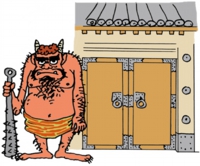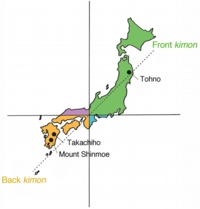“鬼門 kimon”, the word seems not to be used often in recent times. It means a particular direction, northeast. As we can see from the Chinese characters, it’s believed that it’s an unlucky direction because a devil (鬼) goes in and out according to Onmyoudou. On the other hand, there is another belief that it’s a direction that gods go in and out, so then people must keep this place pure. The northeastern direction is called表鬼門 (front kimon), and the southwestern direction is裏鬼門 (back kimon).
According to the Onmyoudou, Abe no Seimei in Heian era in Japan is well-known as a movie was made based on his story. This direction (northeast) is also in relation with the Onmyoudou is a direction to be afraid of. Why is it thought of as an unfortunate direction and why is it something to be afraid of?

Before I talk more about this, there is one thing which I’m concerned about, which relates to the Great East Japan Earthquake. Do you remember there was an eruption at Mount Shinmoe in the Kirishima mountain range on the border between Kagoshima and Miyazaki Prefectures before the earthquake? Because the earthquake was such a devastating incident, the eruption was forgotten about… When “鬼門 kimon” was created in Japan, Kyoto and Nara was the center of Japan. As you can see in the picture below, when drawing lines by putting Kyoto and Nara in the center, Kagoshima and Miyazaki Prefectures are located in the back kimon (southwest) and the Tohoku area which had the earthquake is actually located exactly in front kimon, isn’t it? Mount Shinmoe (新燃岳) which was in the direction of back kimon seemed to have been predicting the catastrophe which includes the nuclear power plant accident, as if the word shinmoe (新/new 燃/burning) had indicated it.

By the way, as for the direction which is called 鬼門kimon, don’t you think that it’s actually the direction which is rich in nature? The Japanese islands seem to be lying in the direction of kimon, too. Takachiho in Miyazaki Prefecture and Tōno in Iwate Prefecture placed in the direction of kimon are the traditional places where there are many remaining stories about the gods and yokai. Also these gods and yokai are the typical things which people are usually afraid of because we can’t see them. The reason that the direction of kimon was disliked and feared may be because the gods and yokai were thought of as a symbol of nature. Fear for the nature was expressed in the meaning of this.
On the other hand of the story about fear, there is actually something about a benefit, too. Because learning about nature makes us learn more things, the government at that time tried to hide the truth (=benefit) to govern citizens by making them believe that the direction of “鬼門kimon” is the one where yokai and gods go in and out. They might’ve been afraid of the citizens becoming wiser by learning more things from natural disasters etc and figuring out more about nature…
As for the word “忌み嫌う(abhor)”, when we have a funeral for someone, we put up the sign that says “忌中 kicyu” up. The word of “忌” is composed with “己 (self)” and “心 (mind)”. When someone dies, various problems which were hidden always come up, such as fighting over the inheritance and so on. Most of people expose their ego. In such a situation, it may be a good chance for you to see inside of yourself (己)you’re your mind (心). That’s why the word “忌中 kicyu” must be used…

Especially when something you didn’t expect happens or when you are in an abnormal situation, you are put to the test. Including the case in natural disasters, especially when you lose something very important, it’s actually a good time for you to rethink about yourself (己). The aftershocks after the big earthquake are still continuing, and actually we ourselves are shaken by it. What does nature try to tell us and how can we learn from it…?
As an aside, Bakin Takizawa, the author of Nansō Satomi Hakkenden, had his unique view that the “桃太郎Momotarō” which was an old Japanese tale, indicated the kimono direction…
Also an old name for higashi-matsushima city in Tohoku was桃生郡 (monou-gun) and there is another place which was called 桃生町 (monou-machi) in Ishimaki city in Tohoku.

